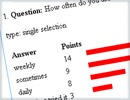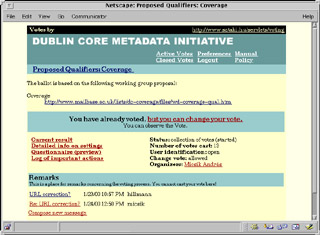
URL of the service: http://voting.sztaki.hu/
The voting system was built on the experience gained in the Web4Groups EU-funded project, for example the in-depth study on voting and rating in everyday life helped to create a generic tool applicable for wide variety of voting purposes. The system is in operation since the beginning of 1999, and it can be used with any standard WWW browser.
In this voting service any registered user can create votes. The creator becomes the organizer of the vote, who prepares and maintains the vote through the organizers' interface. In order to start a new vote, the organizer has to define three kinds of data: user groups, the questionnaire and the control script. The control script and the user groups together define, how the voting process will be executed by the system. If the organizer has conducted other votes before, scripts, questionnaires or user groups can be copied from his/her previous votes. Preparation of a vote can be a collaborative process. Organizers may iteratively refine the questionnaire or other data based on the prospective users' remarks, before the vote is started.
After the organizer starts the vote, the system automatically executes the defined voting process until the end. In this period of time organizers may keep a check on the voting process, and they may intervene in a restricted way. These restrictions are intended to prevent misuse of organizers' privileges. Furthermore, actions taken by the organizers are logged in a public place after the vote has been started. Finally, the vote is closed, but its result and other accompanying data remains accessible for the observers in the archive of closed votes. The system is fully multilingual. Not only the user interface, but the voting data can be multilingual, so it is capable for multilingual polls where the questionnaire and result are shown in several languages at the same time. The graphical layout of the user interface can also be customised according to the wish of the vote organizers. Speaking in current terms the system can have different skins. The system is implemented in Java.
Some detailed features of the service include:
- Five question types: single selection, multiple selection, evaluation, ranking and allocative choice.
- Comments and abstention can be controlled for each question.
- Easy management of user groups
- E-mail notifications and reminders, automatic sending of vote result in e-mail
- Both open and anonymous votes are supported
- Password protected voting processes
- Invitations and automatic private key deliveries to user groups
Some applications of the system:
- Victoria state (in Australia) tested for collecting public opinion on state slogan for car number plates
- Hungarian Prime Minister's Office collected user feedback on new page design
- Dublin Core Metadata Initiative used it for the approval of DC qualifiers
- Opinion polls were conducted by the SELECT EU-funded project and the DELOS Working Group on Digital Library Testing and Evaluation

